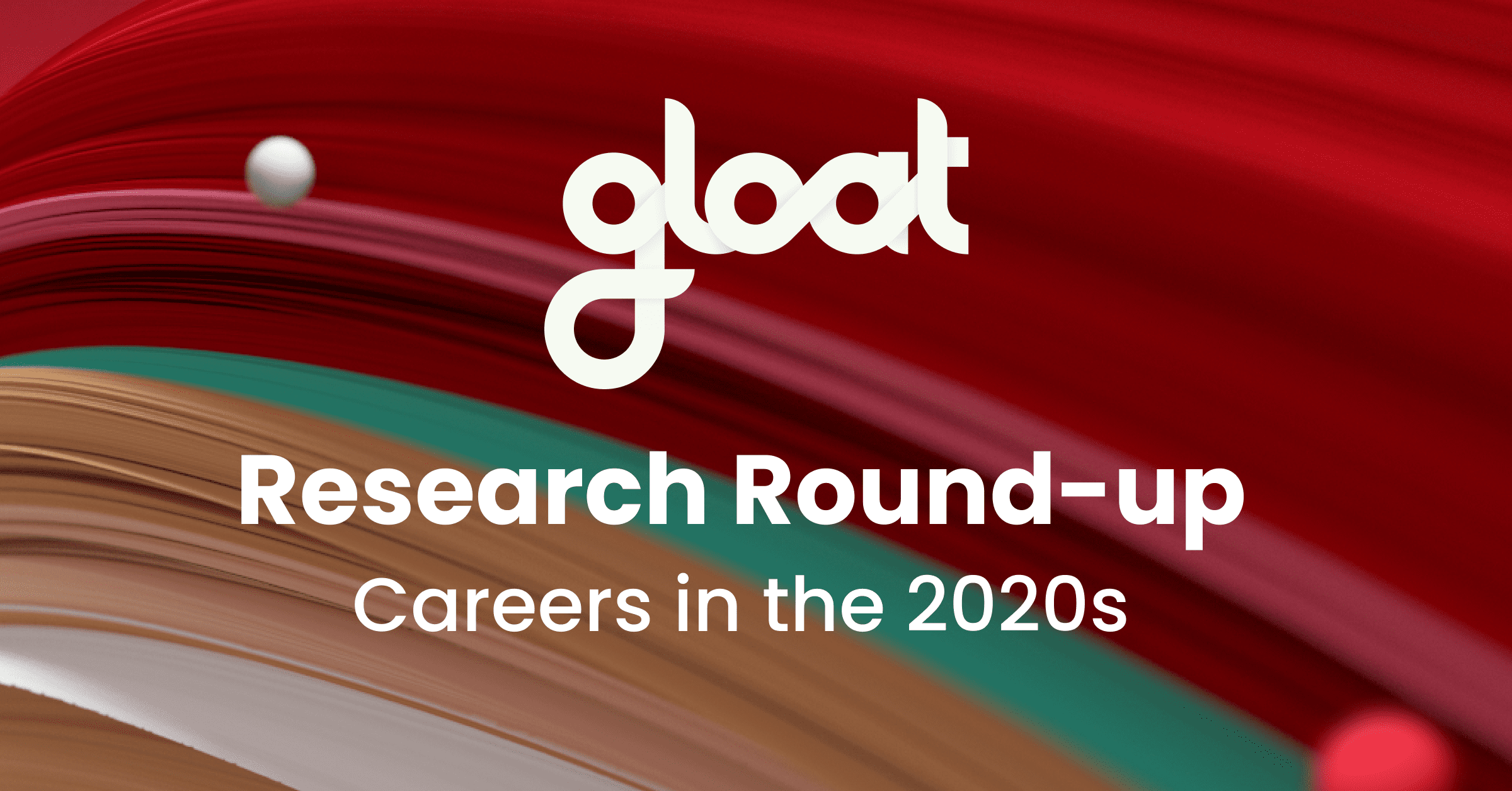September Research Round-Up
What I’m Reading, Listening to, and Thinking About in the World of Talent Marketplaces -- Careers in the 2020s

Can you believe it has been almost 6 months since April’s eye-opening jobs report sparked conversations about attrition and labor shortages? In the weeks that followed, we’ve gotten a lot of names for what’s happening and plenty of theories about who’s responsible for it. The Great Resignation. The Great Retirement. The Great Re-assessment (one of our favorites). But as we approach the half-year mark in this retention and re-assessment crisis, we’re just starting to address the issue that sits at the heart of it: that the way employees and business leaders need to approach and frame careers has profoundly changed.
To put it simply, careers in the 2020s are different. We’re no longer content with climbing a linear ladder and taking one predictable step after another. During the height of the pandemic, we all had to abandon our role’s predefined confines, take on new responsibilities, and come together to overcome unprecedented disruption. And now, in the wake of it, we know we’re capable of so much more than what we were hired to do. There’s no going back.
We need to turn our gaze forward and think about how we can build meaningful careers and workplaces that are designed to support them. We may not have a blueprint for that just yet, but we do have powerful strategies and technology like talent marketplaces to help us see our employees for who they really are: the breadth of experiences they’re bringing to the table, the skills and capabilities they’ve mastered (both on our watch and in their personal lives), and the personal goals, interests and aspirations that will shape their next steps. And we also have research, insights, and stories from those who’ve already begun the work that we all need to do, reimagining careers and architecting new ways of working that put employees at the helm of their own growth and development.
Since we can all benefit from a little guidance as we step into this uncharted territory, I’ve handpicked some of my favorite pieces about how careers in the 2020s are evolving for the new world of work:
READ: What’s new in thought leadership about the future of work
Should I Stay? Should I Go? by Rishad Tobaccowala
The author of a recent bestseller, Restoring The Soul of Business: Staying Human in the Age of Data, Rishad’s blog summarizes, elegantly, the three questions employees are asking about their careers and lives in the 2020s. In three words: freedom, story, and growth. Freedom: Can you be free to become who you are? Can you have autonomy in your work? Story: If you shift how does it fit in the story arc of your career? How does it reflect in your legacy if you are senior? Growth: Can you find ways to grow where you are, or do you have to leave? Well written and thought provoking.
The Key Role of Dynamic Talent Allocation in Shaping the Future of Work, McKinsey, by Elizabeth Foote, Bryan Hancock, Barbara Jeffery, and Rob Malan
This McKinsey article gets straight to the point: flexibility needs to be at the center of our approach to careers. Not only will a more dynamic strategy appeal to employees who are looking for choice and agency, it’ll also enable more agile ways of working through the creation of pools of resources that can be deployed on-demand, as new challenges emerge. This approach already has proven results behind it, as McKinsey cites research performed during the pandemic which showed that responsive organizations outperformed their less agile peers and doubled their odds of achieving success.
The Skills-Based Organization, Deloitte, by Michael Griffins
Traditional talent strategy rules need a rewrite, and the updated model is going to put capabilities at the center. Deloitte introduces the concept of a skills-based organization, or SBO, a new organizational form that reimagines units of work as a dynamic landscape of skills that can be agilely deployed to work as business priorities evolve. In a world of SBOs, people will be served up customized opportunities based on their unique portfolio of skills, something that talent marketplaces can already make possible with dynamic career pathing that presents employees with a curated selection of projects, gigs, and roles that align with what they’ve done in the past and what they’re looking to achieve next.
The U.S. Workforce Has Gotten Significantly Older and More Diverse, CNN, by Alicia Wallace
Another reason why careers need to evolve? To keep up with the demographic changes we’re experiencing. CNN explores some of the key shifts, including a workforce that is older and pursuing longer careers, an uptick in educated employees, and a population that is increasingly diverse. When it comes to far-reaching impacts, one thing that we will all need to think about is how our approach to careers will change as lives get longer. Employees who are entering the workforce today can expect to work for 50 or 60 years and will likely encounter many chapters of reinvention throughout their lengthy careers. Consequently, the old three-box model is no longer relevant; instead, it’s being replaced with an ebb and flow of a portfolio of learning, work, and personal pursuits.
The Job Market is Hot: Now is the Time to Build Your Career, Forbes, by Tracy Brower
This Forbes article speaks directly to employees who are thinking about making a switch, which makes it a valuable resource for leaders who are looking to take a walk in their people’s shoes and see careers from their perspectives. When detailing what this competitive job market has to offer, skills development earns a spot at the top of the list. A study from Monster.com found that about 3 in 10 employees are quitting their jobs because they feel like they don’t have adequate growth opportunities and almost half of all workers said they would be more likely to stay with their employer if they were more invested in their long-term growth.
LISTEN: What I’ve been playing on repeat
Will The Future of Work Leave Workers Behind?, Innovation Hub, with David Autor and Betsey Stevenson
We may have come a long way from the darkest days of the pandemic, but there’s still a lot of uncertainty, especially in the service industry. As record numbers of frontline employees leave their roles in search of new environments and better pay and benefits, are we approaching the dawn of a new automation age in which non-human labor will rapidly replace workers? MIT economist David Autor and Betsey Stevenson, who served as Chief Economist at the U.S. Department of Labor, explore how COVID-19 will impact the way we work for years to come. PS: there’s more good news here than you might have expected.
THINK: What research and studies are saying about our path forward
As a Population Gets Older, Automation Accelerates, MIT News Office, by Peter Dizikes
While the pandemic certainly accelerated the change in careers we’re seeing today, it isn’t the only force at play. For years, experts have predicted that automation will shakeup the workplace, and a recent study co-authored by MIT professor Daron Acemoglu is shedding some light on the regions where robots are gaining traction fastest. The answer might surprise you: workplace automation is becoming most widely adopted in populations that are notably older, filling the gaps in an aging industrial workforce. The research also points out a key difference in how these technologies are being utilized across the globe. While the US primarily adopts automation as a cost-cutting, worker replacement strategy, countries like Germany utilize robots in response to labor shortages.
ICYMI: What I keep coming back to
Careers Are No Longer Ladders to Climb. Here’s How to Develop Professionally Instead, Fast Company, by Ben Reuveni
I might be a little biased, but I would argue that this Fast Company article written by Gloat’s CEO should be required reading for leaders who are rethinking talent management. As Ben points out, yesterday’s career ladders have been replaced by lattices of vertical and horizontal opportunities that are shaped by personal and professional aspirations. In the midst of this turnover tsunami we’re still struggling with, creating more meaningful development opportunities needs to be top priority, especially since our research shows that a lack of growth opportunities is the number one motivator that inspires employees to switch jobs.
Cross-Silo Leadership, Harvard Business Review, by Amy C. Edmondson, Sujin Jang, and Tiziana Casciaro
Maybe horizontal career moves are on your radar, but what about horizontal teamwork? Even before COVID-19’s onset, Harvard Business Review was emphasizing the importance of cross-boundary collaboration, and it’s arguably become even more necessary today. The article suggests that employees can learn more, sell better, and gain skills faster when they reach out of their silos to find colleagues with complementary expertise. The most important takeaway: innovation hinges on interdisciplinary cooperation, and as digitalization transforms business at a breakneck pace, the demand for executives who can lead projects at interfaces will continue to rise.
Nine Keys to Becoming A Future-Ready Company, McKinsey, by Aaron De Smet, Chris Gagnon, and Elizabeth Mygatt
McKinsey released nine keys to becoming a future-ready company at the start of 2021 that I think we will need to take with us into 2022 and beyond. The article advises leaders to “treat talent scarcer than capital” and recognizes that talent ecosystems often allow for the best management and allocation of the workforce. McKinsey also shines a spotlight on a few forward-thinking enterprises that have begun leveraging tech-enabled marketplaces to better match skills to projects.
CONNECT: What future-fit organizations and leaders are talking about
Amit Garg, Linkedin
It’s impossible to talk about career progression and reimagining growth opportunities without bringing L&D into the discussion. Amit Garg, Host of the L&D Go Beyond Podcast, makes an important point, saying it’s time to retire the idea that becoming “the Netflix of Learning” should be the goal for upskilling initiatives. At the end of the day, we can’t just watch a video to master new concepts. We also need the chance to put the lessons we’ve learned into action, which is where hands-on experience in the form of projects and gigs comes into play. As Amit notes, we all need to prioritize practice if we want to build skills than can be deployed efficiently and accurately.
Let us know what you would add to our list.





